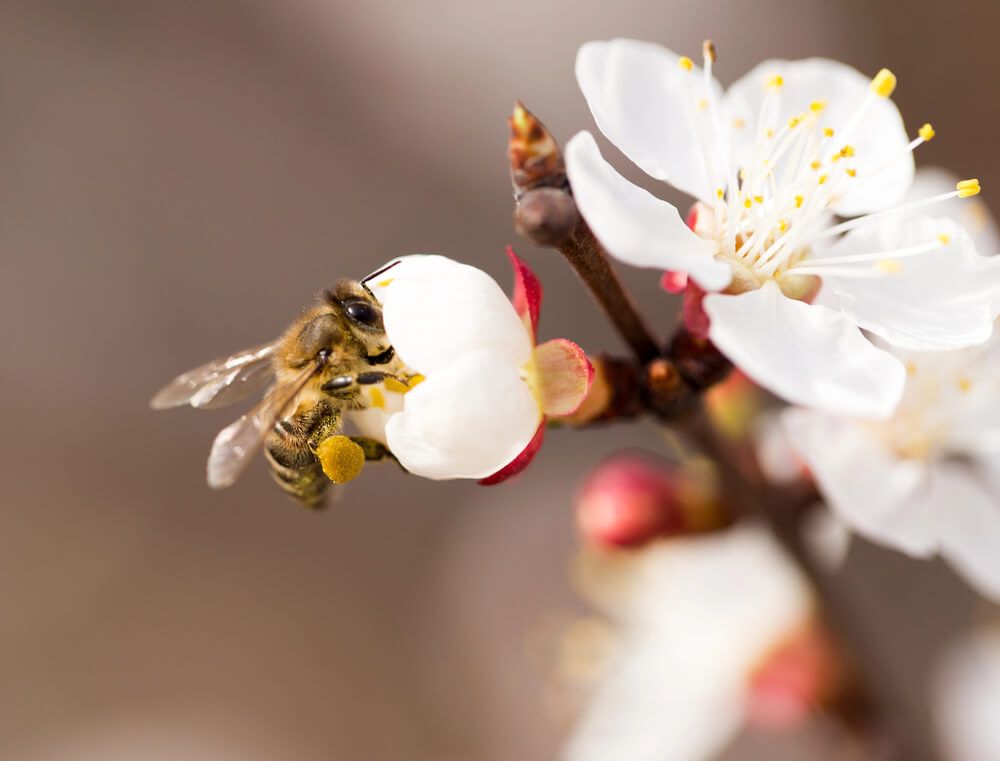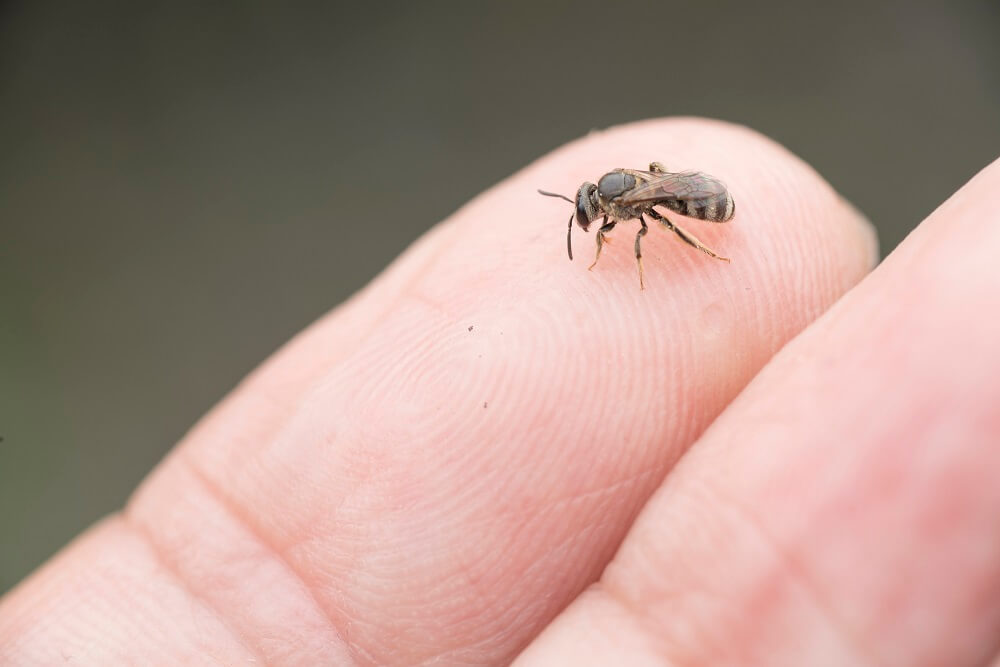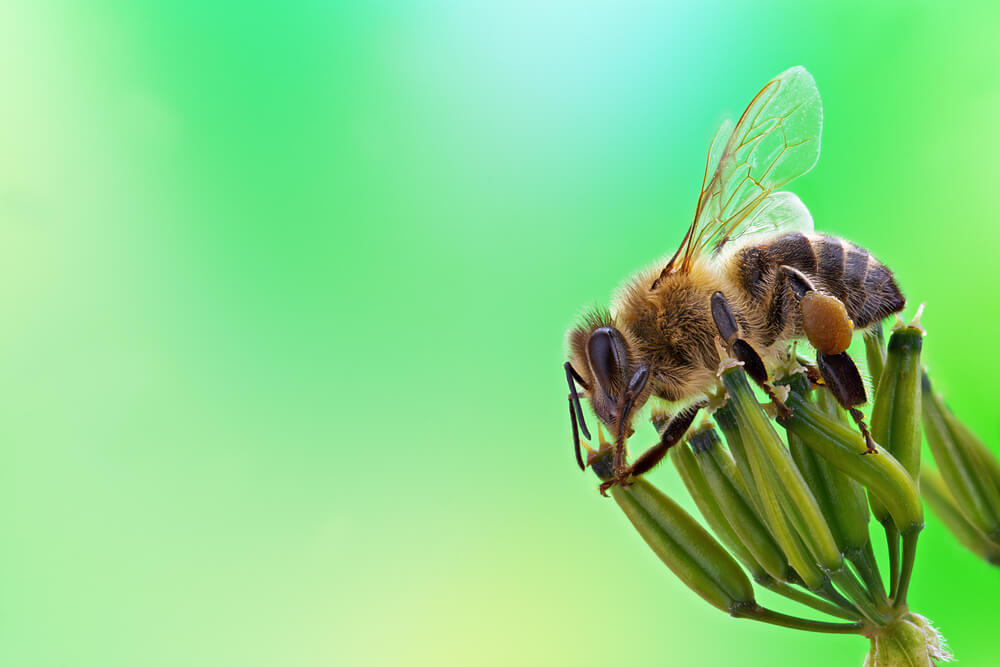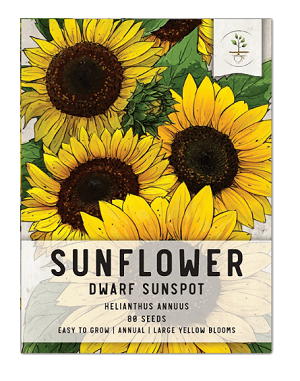Table of Contents:
What Are the Best Sunflowers for Bees?
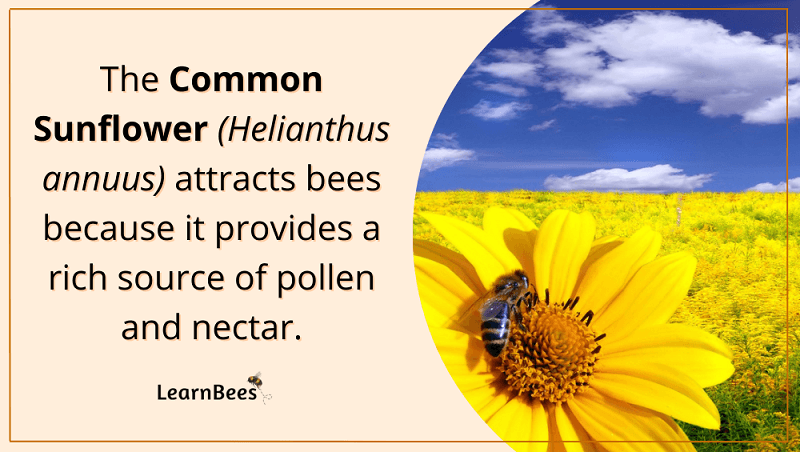
The Common Sunflower (Helianthus annuus) is one of the best sunflowers you can plant for bees.
Dwarf Common Sunflowers reach only two feet tall with an 18″ spread. They’re annuals that provide beautiful blooms from summer until fall. Plant them in a full-sun location for maximum flowering.
Other varieties of Common Sunflowers, such as Mammoth Grey Stripe, can reach heights of six to ten feet tall, with huge ten-inch wide flower heads.
Fortunately, Mammoth Grey Stripe sunflowers have sturdy stalks that don’t require staking. Provide them with full sun to get the most blooms.
Better yet?
The Common Sunflower is native to the lower 48 states.(1, 2)
This means if you want the best chance of attracting the most bees, then this sunflower will do the trick. Bumble bees, mason bees, sweat bees, and other bees all flock to Common Sunflowers like a magnet.
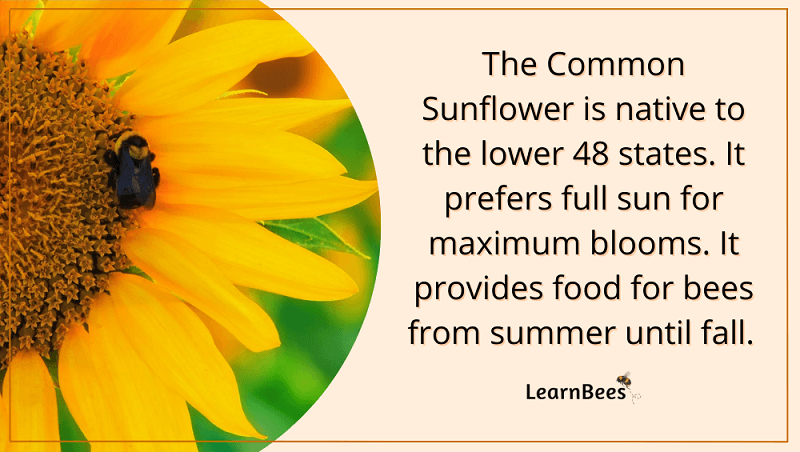
With that said, it’s important to remember:
The best sunflowers for bees are ones that are native to your area.
For example, sunflowers that are native to South Florida may be entirely different than those that are native to Nevada. This is because Nevada bees have adapted to a completely different climate than Florida bees.
Take swamp sunflowers, for example.
Swamp sunflowers (Helianthus angustifolius) are native to Florida. They thrive in wet, boggy areas that keep their roots moist.(3, 4)
As such, swamp sunflowers wouldn’t survive in the Mojave Desert of Nevada.
Bees are no different.
Like native plants, bees have adapted to their local conditions. Many native bees won’t even touch non-native flowers like hostas, peonies, or cherry blossoms.
You can find native sunflowers by using Native Plant Finder. You can also search online for sunflowers native to your region.
For instance, examples of searches include:
- “Native sunflowers for Central Ohio”
- “Native sunflowers for South Texas”
- “Native sunflowers for Northern Oregon”
Are All Sunflowers Good for Bees?
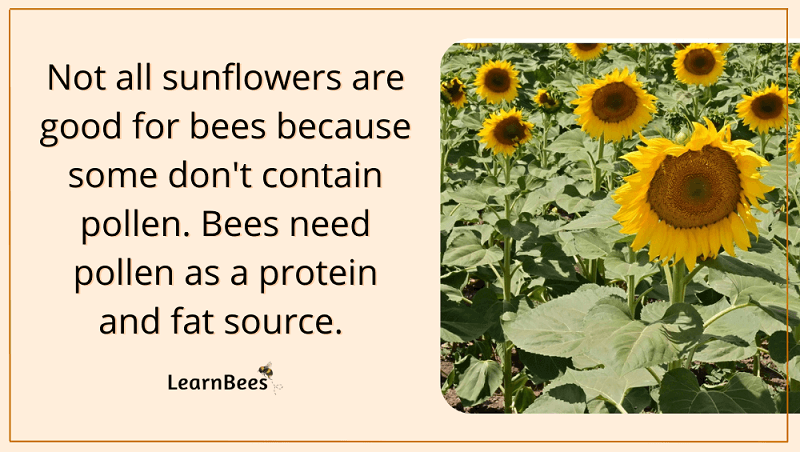
Not all sunflowers are good for bees.
Certain sunflowers, like pollenless sunflowers, are grown for flower arrangements instead of bees. Since they don’t have pollen, they don’t shed and make a mess. This makes them ideal for bridal bouquets and other gatherings.(5)
But for bees?
Not so much.
Bees rely on pollen and nectar from flowers.
Pollen contains proteins, fats, and other nutrients crucial for a bee’s growth and development. Bees use the pollen they collect to feed baby bees and pollinate other flowers.(6, 7)
The good news?
When you plant native sunflowers, you’re helping more than just bees. You’re also helping your local butterflies, ladybugs, moths, and other vital pollinators.
Native sunflowers can also lower your garden’s maintenance because the plants are well-acclimated to your region. They tend to require less watering and fertilizer and are more naturally resistant to pests. (8, 9)
For example, you wouldn’t want to plant Swamp Sunflowers in a dry climate unless you have the time and water resources to keep them wet. But, you can choose a different sunflower variety that works for you.
Do Bees Make Honey From Sunflowers?

Honey bees (Apis mellifera) produce sunflower honey from the nectar of sunflowers.
Raw sunflower honey has a sweet taste with floral notes. The flavor is smooth and rich, making it delicious paired with other foods or straight off the spoon. The color is a medium golden shade.
But how is sunflower honey made?
When a honey bee visits a sunflower, it uses its tongue to collect nectar from the base of the flower.
The bee then stores the nectar in an internal organ called a honey crop. The honey crop acts as a carrying pouch for the bee to tote the nectar around until it’s ready to fly back to the nest.
From there, the bee has special enzymes that help turn the nectar into honey.
But not all bees make honey.
Honey bees are actually the only bee species that make enough honey for humans to eat. Other bee species, like bumble bees, produce only small amounts of honey. As such, bumble bee honey isn’t sold in mass like honey from honey bees.
FAQs on Sunflowers for Bees
- What do bees eat on sunflowers?
- What are the best sunflowers for honey bees?
- Which sunflower produces the most nectar?
- Do sunflowers reduce varroa mites?
- Why do bees like sunflowers so much?
- Do sunflowers attract a lot of bees?
- Do bees sleep on sunflowers?
- Do bees like pollenless sunflowers?
- Can bees smell sunflowers?
What do bees eat on sunflowers?
Bees eat nectar and pollen from sunflowers.
Nectar is a sugary liquid produced by flowers that bees use as a source of energy, while the pollen contains proteins, fats, and other nutrients essential for bee growth and development. Pollen is the yellow powdery substance bees collect from flowers and carry back to their nests.
There are over 20,000 bee species that require flowers to survive. Mason bees, leafcutter bees, and bumble bees are examples of bees that feed on sunflower nectar and pollen.
Additionally, when you plant native sunflowers, it’s good for more than just bees. It helps feed your local ecosystem, including birds and other insects. Pollinators rely on flowers for food and shelter, so give them the best of both worlds by planting native flowers like sunflowers, rudbeckias, and more.
—> Go back to the FAQs on sunflowers for bees
More to Explore:
What are the best sunflowers for honey bees?
Honey bees are generalist feeders that will visit various plants in search of nectar and pollen. One of the best sunflowers for honey bees are Common Sunflowers.
Common Sunflowers (Helianthus annuus) like full sun and well-drained soil. They come in many sizes ranging from two feet tall to ten feet tall. Dwarf varieties work for people with small gardens with limited space.
Larger varieties of sunflowers can be planted in open spaces for a stunning splash of color. You’ll also attract more than just honey bees when you grow Common Sunflowers.
Birds, butterflies, ladybugs, and other animals will use sunflowers as a food source. For instance, many birds love to eat sunflower seeds.
—> Go back to the FAQs on sunflowers for bees
More to Explore:
Which sunflower produces the most nectar?
The Common Sunflower (Helianthus annuus) produces abundant nectar and pollen for bees. It’s also native to the lower 48 states and grows well in most climates.
You can also find other varieties of sunflowers that thrive in your area. Chances are, sunflowers native to your region will produce ample nectar because they’re happy and healthy in that environment.
For instance, sunflowers that prefer wet and boggy environments will perform well in swamplands. Swamp sunflowers feed the local bees (and other animals) in coastal regions like Florida and Louisiana. They produce generous amounts of nectar and pollen for swamp-dwelling insects.
—> Go back to the FAQs on sunflowers for bees
More to Explore:
Do sunflowers reduce varroa mites?
One study found that the availability of sunflower pollen was linked to a reduced Varroa mite infestation. However, more research is needed to test and confirm this.(10)
The authors of the study state that their findings are only a starting point. They highlight the importance of further research to expand upon their findings.
Nobody has been able to copy the results of this study yet because it was only recently published. It’s important that other scientists can repeat it so we can confirm whether sunflower pollen actually reduces varroa mites.
Plus, a detectible difference isn’t the same thing as an economically significant difference. We don’t know if using sunflower pollen would be helpful. We don’t know if it could replace other treatments, help with them, or not make a difference at all.
We don’t know how much sunflower pollen a colony of bees needs to stay healthy and survive for a long time. We don’t know how much pollen is too much for a colony. More sunflower pollen may have diminishing returns when it comes to treating mites.
We also don’t know if sunflower pollen is worse, better, or comparable to the pollen from other plants of the Asteraceae family. Asteraceae includes thousands of plant species, from daisies to asters, marigolds, and dandelions.
All these are essential questions that need to be answered before answering, “Do sunflowers reduce varroa mites?” We simply don’t know yet.
The good news is that this research has started. Hopefully, this study will continue to encourage scientists to study sunflower pollen’s effect on varroa mites.
—> Go back to the FAQs on sunflowers for bees
More to Explore:
Why do bees like sunflowers so much?
Bees are attracted to sunflowers because they produce large quantities of pollen and nectar, which are essential food sources for bees.
Bees need nectar and pollen for different reasons:
- Nectar: Nectar is a sweet liquid produced by flowers and serves as the primary energy source for bees. Bees collect nectar using their long tongues and store it in their honey crops which is an internal organ. Once back at the nest, they regurgitate the nectar and pass it from bee to bee until it is transformed into honey, which serves as the primary food source for the colony during the winter months when flowers are scarce.
- Pollen: Pollen is a powdery substance produced by the male reproductive organs of flowers. Bees collect pollen using their body hairs and pack it into small balls on their hind legs, known as “pollen baskets.” Pollen is a crucial source of protein and other nutrients for bees, and it is essential for the development and growth of bee larvae. Additionally, bees use pollen to make “bee bread,” which is a mixture of pollen, nectar, and enzymes that are stored in the honeycomb and serves as a protein-rich food source for the colony.
Sunflowers are also accessible for bees to land on and access pollen and nectar because of their large, open flower heads. Bees are attracted to accessible sources of nectar and pollen, so open flower heads appeal more to them than double flower heads.
—> Go back to the FAQs on sunflowers for bees
More to Explore:
Do sunflowers attract a lot of bees?
Sunflowers attract many native bee species, like bumble bees, carpenter bees, and mason bees. They’re long-blooming flowers which is beneficial, especially in times of nectar dearth.
A nectar dearth is when there is a scarcity of nectar-producing flowers available for pollinators to feed on. This can occur naturally, such as during times of drought or extreme weather, or as a result of human activities, such as urbanization and land development, which can lead to the destruction of natural habitats and the reduction of wildflowers.
During a nectar dearth, pollinators such as bees, butterflies, and hummingbirds may struggle to find enough food to survive. This can lead to a decline in their populations and a decrease in their ability to pollinate crops and other plants.
—> Go back to the FAQs on sunflowers for bees
More to Explore:
Do bees sleep on sunflowers?
Bees sometimes sleep on sunflowers if they need to rest after a long day of foraging. This is especially true for male bees who don’t have an actual “nest” like female bees do. Male bees often hang out among flowers because they aren’t nest-building like female bees are.
—> Go back to the FAQs on sunflowers for bees
More to Explore:
- What Are Black and Yellow Wasps?
- How Long Do Bumble Bees Live?
- Honeybees vs. Bumblebees: How Do They Compare?
Do bees like pollenless sunflowers?
Bees don’t like pollenless sunflowers because pollen is a significant food source. Without pollen, bees cannot provide enough nutrients for the colony, and their brood may suffer as a result.
—> Go back to the FAQs on sunflowers for bees
More to Explore:
- Wasps vs. Honey Bees: Are They Different?
- Are Worker Bees Male or Female?
- Queen Bee Versus Worker Bees – How Do They Compare?
Can bees smell sunflowers?
Research suggests that bees can smell flowers. One study showed that honeybees could establish stable and long-term memory for food stored inside their nests. The scientists also found that this can influence the bees’ choice of flowers to visit later.(11)

